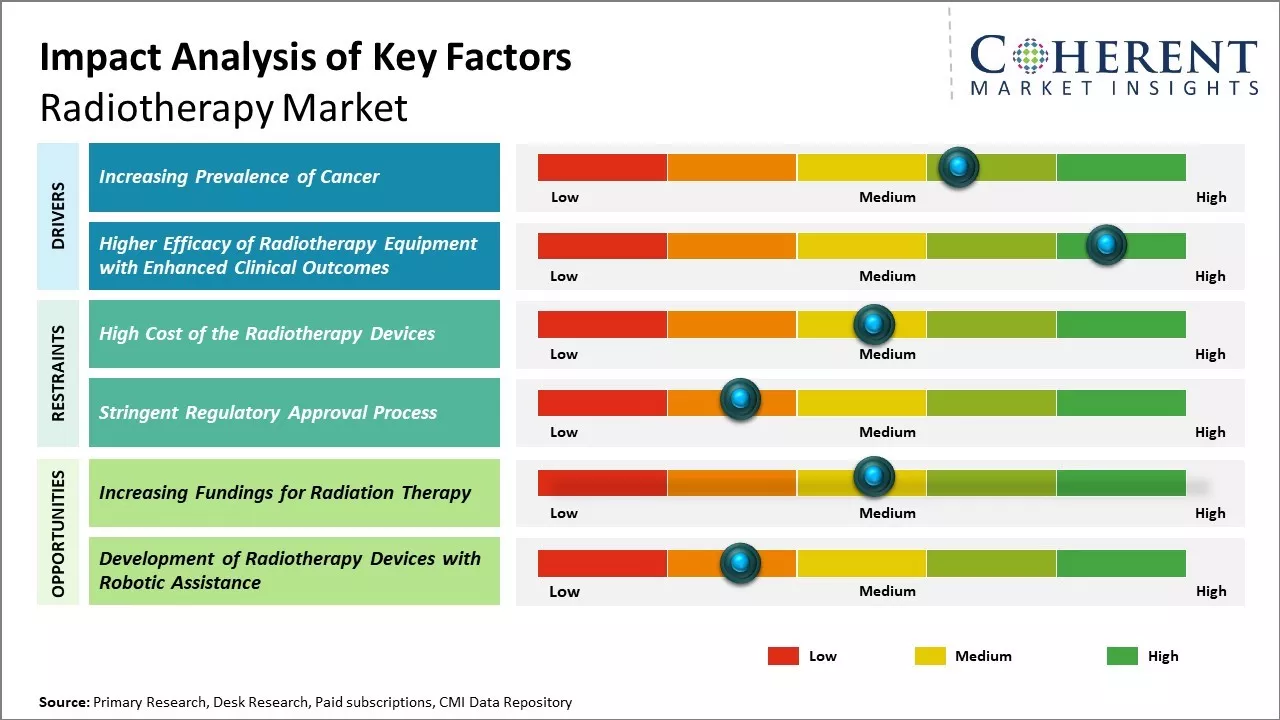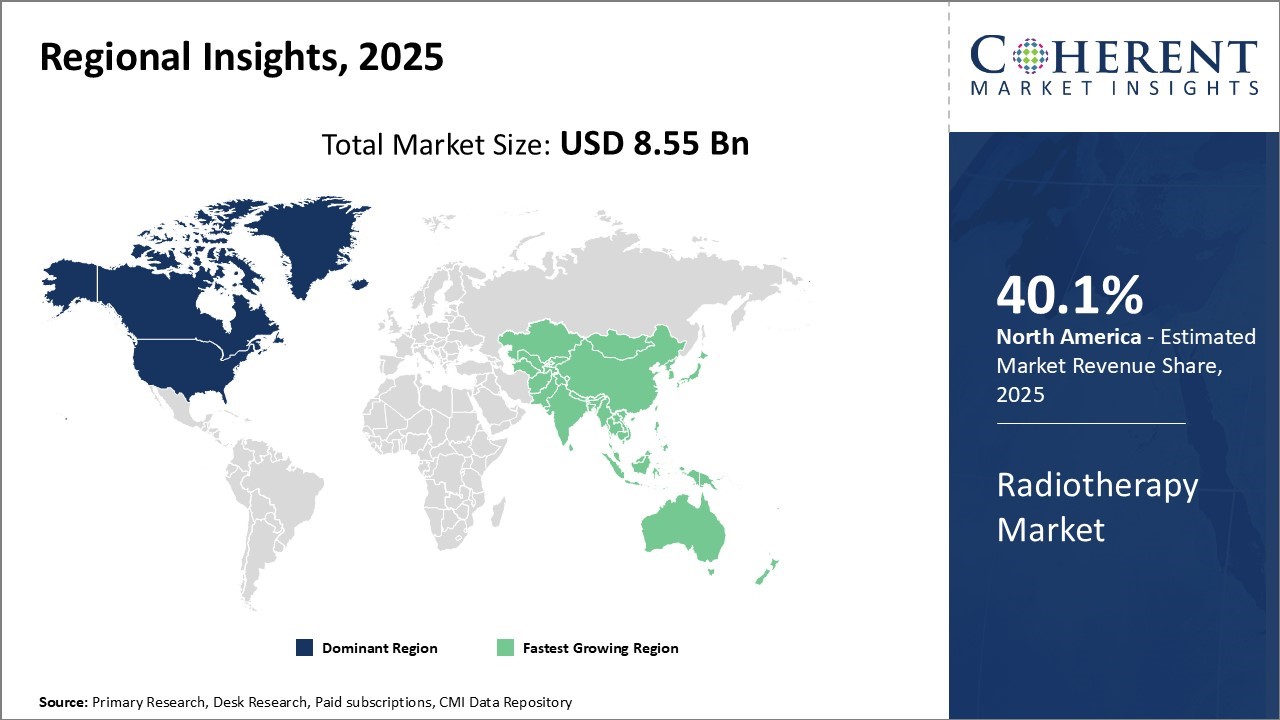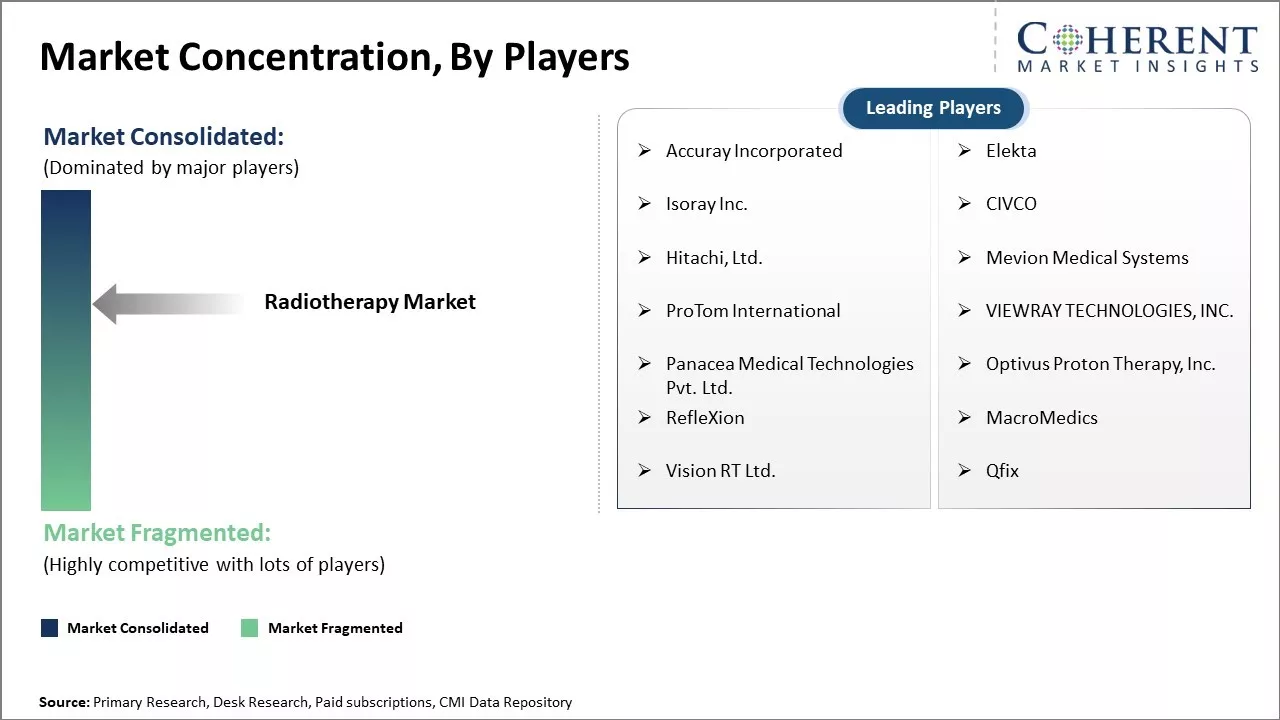
The global radiotherapy market is estimated to be valued at USD 8.55 Bn in 2025 and is expected to reach USD 14.01 Bn by 2032, exhibiting a compound annual growth rate (CAGR) of 7.3% from 2025 to 2032.

To learn more about this report, Download Free Sample
The increasing prevalence of cancer around the world is the key factor driving the radiotherapy market demand. Additionally, the rising adoption of advanced treatment techniques, such as intensity-modulated radiation therapy (IMRT) and stereotactic body radiation therapy (SBRT), is also boosting the growth of the industry. Furthermore, the growing awareness about the therapeutic advantages of radiotherapy compared to other cancer treatment options is augmenting the market expansion.
|
Current Events |
Description and its impact |
|
Technological Innovations |
|
|
Market Expansion Initiatives |
|
Uncover macros and micros vetted on 75+ parameters: Get instant access to report
Artificial Intelligence (AI) is rapidly transforming radiotherapy from a largely protocol-driven process into a highly personalized and adaptive treatment modality. At its core, AI enhances every stage of the radiotherapy workflow—ranging from treatment planning and dose calculation to real-time tumor tracking and adaptive response—thereby addressing long-standing challenges related to precision, efficiency, and patient outcomes.
For instance, HCG Cancer Hospital in Bengaluru, one of the nation’s premier dedicated cancer centers, launched Varian Ethos therapy system. This platform exemplifies the integration of AI in radiotherapy by offering a holistic solution designed to elevate the capability, flexibility, and operational efficiency of treatment delivery.
The reimbursement landscape for radiotherapy is at a pivotal juncture, as policymakers increasingly recognize the need to move beyond traditional fee-for-service models that incentivize volume over value. In March 2025, bipartisan legislation was reintroduced in Congress aiming to overhaul Medicare’s reimbursement framework for radiation oncology services. This legislation, known as the Radiation Oncology Case Rate (ROCR) Value Based Payment Program Act, represents a strategic shift from quantity-based to episode-based payments.
According to the American Society for Radiation Oncology (ASTRO), this legislation has the potential to “transform” Medicare reimbursement for radiotherapy by stabilizing the declining reimbursement rates that have long challenged providers in this field.
The product type segment includes external beam radiation, internal beam radiation, and systemic radiation. The external beam radiation sub-segment is estimated to hold 61.8% of the market share in 2025, owing to continuous refinement and the development of external beam radiation therapy modalities over the past few decades. The advent of sophisticated image-guided radiation therapy systems that leverage technologies, such as computed tomography (CT), magnetic resonance imaging (MRI), Positron emission tomography (PET) scanning, and linear accelerators, has improved precision and targeting capabilities for external beam treatments. Additionally, the emergence of highly conformal modalities such as intensity-modulated radiation therapy (IMRT) and volumetric modulated arc therapy (VMAT) allows for better dose distribution and sparing of surrounding healthy tissues. Advancements have also made it possible to deliver higher radiation doses in fewer treatment sessions through techniques like stereotactic body radiation therapy (SBRT). This has translated to better treatment outcomes and patient convenience.
For example, according to an artice published by Radiology Info, delivering External Beam Therapy (EBT) involves a collaborative team that includes a radiation oncologist, medical physicist, dosimetrist, and radiation therapist. The radiation oncologist is responsible for assessing the patient and selecting the most suitable treatment. They also identify the specific areas to be targeted and determine the total radiation dose to be administered.
The therapy type segment includes external beam radiation therapy, internal beam radiation therapy, and systemic radiation therapy. The external beam radiation therapy sub-segment is estimated to hold 47.7% of the market share in 2025 due to its diverse applicability across cancer sites. Traditionally used to treat primary tumors, external beam radiation is increasingly being leveraged in adjuvant, neoadjuvant, and salvage settings. It is often combined with chemotherapy to achieve enhanced locoregional control. Additionally, advancements in delivery techniques now allow safer delivery of ablative radiation doses through hypofractionated regimens for oligometastatic diseases. Emerging data also indicates the potential of post-operative radiation to further reduce the risk of recurrence in high-risk cancer types. These expanding indications across the cancer care continuum have continued to drive the demand for external beam radiation therapy solutions and services.
The end user segment includes hospitals, oncology clinics, and ambulatory radiotherapy centers. The hospital's sub-segment is estimated to hold 51.8% of the market share in 2025, owing to their central role in comprehensive cancer care. Most hospitals are equipped with advanced radiology departments housing the latest external beam radiation therapy systems. They also boast well-staffed teams of radiation oncologists, medical physicists, dosimetrists, and nursing personnel with clinical expertise to handle the complexities of radiation treatment planning and delivery. Moreover, the colocation of radiotherapy within hospitals facilitates crucial multidisciplinary collaboration with surgical oncologists, medical oncologists, and other specialists to arrive at optimal coordinated treatment strategies. Apart from this, hospitals provide a one-stop shop for cancer patients requiring additional services under one roof, such as PDT, chemotherapy, palliative care, etc. These attributes cement the position of hospitals as the preferred setting for radiotherapy procedures. For instance, in June 2025, a Cancer Care Facility was inaugurated at ILS Hospital in Agartala, India. It aims to enhance the regional access to radiotherapy.

To learn more about this report, Download Free Sample
North America remains the dominant region is estimated to hold 40.1% of the radiotherapy market share in 2025, owing to a well-established healthcare infrastructure and strong presence of industry players in the region. The growth in the U.S. market share due to high adoption of advanced treatment devices such as proton therapy systems and brachytherapy products among other hospitals and cancer care centers. Moreover, favorable reimbursement policies for diagnostic imaging and cancer treatment procedures have further driven the market growth. For instance, in March 2025, Actinium Pharmaceuticals launched the ATNM-400. It is a novel alpha-emitting radiotherapy for prostate cancer. Canada also follows closely with strong investments in public healthcare and adoption of advanced technologies in the early stages.
The Asia Pacific region has emerged as the fastest-growing market. Countries like China, India, Japan, and South Korea are witnessing rapid economic development, which is improving access to advanced healthcare facilities. Rising healthcare expenditure, growing public awareness about cancer treatment options, increasing geriatric population base are some of the key factors fueling the Asia Pacific radiotherapy market. The market is witnessing higher imports from global majors to meet the domestic demand. Many global original equipment manufacturers (OEMs) have also set up manufacturing bases or entered into partnerships with local players in high-potential countries. This has ensured a steady supply of devices and made them more affordable. As the availability of technologically sophisticated products increases in the region, more patients are opting for advanced radiation therapy procedures. China and India are the best performing countries in the Asia Pacific radiotherapy market. China dominates the market with support from the government for healthcare reforms, there are also rising incidences of cancer cases, etc. Whereas in India, there is a rapid expansion in cancer care centers, rise in awareness, etc.
For instance, in December 2024, the new TrueBeam STx 3.0 linear accelerator was inaugurated at the KIMSHEALTH Cancer Centre in Thiruvananthapuram, India. It is an advanced radiotherapy system that integrates Surface-guided radiotherapy which enables high-precision treatment for lung, breast, and prostate cancer, etc.

To learn more about this report, Download Free Sample
| Report Coverage | Details | ||
|---|---|---|---|
| Base Year: | 2024 | Market Size in 2025: | USD 8.55 Bn |
| Historical Data for: | 2020 To 2024 | Forecast Period: | 2025 To 2032 |
| Forecast Period 2025 to 2032 CAGR: | 7.3% | 2032 Value Projection: | USD 14.01 Bn |
| Geographies covered: |
|
||
| Segments covered: |
|
||
| Companies covered: |
Accuray Incorporated, Elekt, Isoray Inc., CIVCO, Hitachi, Ltd., Mevion Medical System, ProTom International, VIEWRAY TECHNOLOGIES, INC., Panacea Medical Technologies Pvt. Ltd., Optivus Proton Therapy, Inc., RefleXion, MacroMedics, Vision RT Ltd., and Qfix |
||
| Growth Drivers: |
|
||
| Restraints & Challenges: |
|
||
Uncover macros and micros vetted on 75+ parameters: Get instant access to report
Higher Efficacy of Radiotherapy Equipment with Enhanced Clinical Outcomes is an emerging trend in the radiotherapy market. New technology is replacing the traditional and age-old machines and models. With machines like MR-Linacs, proton therapy systems, and SGRT it could be better for focusing on tumors and avoiding healthy tissues at the same time. This would also lead to better results such as a lower chance of the cancer cell regenerating and coming back. The high-energy radiation used during radiotherapy permanently damages the DNA of cancer cells, causing them to die. According to the data provided by Mayo Foundation for Medical Education and Research (MFMER), in July 2020, almost half of all people with cancer have radiotherapy as part of their treatment plan. Moreover, according to the data published by NHS inform, in November 2021, four out of every 10 cancer cures include radiotherapy as part of the treatment plan.
The rising prevalence of oncology diseases, such as prostate cancer, lung cancer, and breast cancer, globally is increasing the demand for timely management to reduce mortality associated with such conditions. This, in turn, is a major factor augmenting the growth of the radiotherapy market. For instance, according to data provided by Breastcancer.org, in March 2022, an estimated 287,850 new cases of invasive breast cancer were expected to be diagnosed in women in the U.S., along with 51,400 new cases of non-invasive (in situ) breast cancer 2022. This is further positively influencing the radiotherapy market forecast.
Increasing adoption of inorganic growth strategies such as fundings is expected to offer lucrative growth opportunities in the market. For instance, the National Institutes of Health (NIH) granted a funding of USD 12 million to the Abramson Cancer Center at the University of Pennsylvania, U.S. to study ultra-fast, high-dose FLASH radiation therapy for cancer. This is further propelling the radiotherapy market share.
*Definition: Radiotherapy, also known as radiation therapy, uses ionizing radiations that deliver targeted beams of radiation to kill and destroy cancer cells. The advanced technology used in radiotherapy works by bombarding cancerous cells with radiation to kill them, while minimizing damage to the healthy cells around them. Radiotherapy is the most potent and cost-effective treatment for cancer, and when integrated with advanced technologies, such as image-guided therapy, it leads to enhanced control over the tumor and toxicity.
Share
Share
About Author
Manisha Vibhute is a consultant with over 5 years of experience in market research and consulting. With a strong understanding of market dynamics, Manisha assists clients in developing effective market access strategies. She helps medical device companies navigate pricing, reimbursement, and regulatory pathways to ensure successful product launches.
Missing comfort of reading report in your local language? Find your preferred language :
Transform your Strategy with Exclusive Trending Reports :
Frequently Asked Questions
Joining thousands of companies around the world committed to making the Excellent Business Solutions.
View All Our Clients